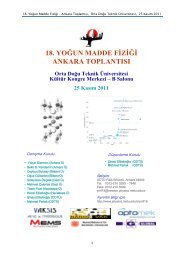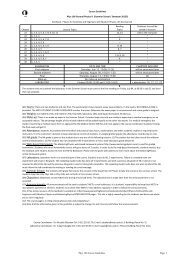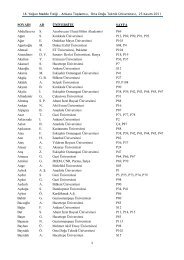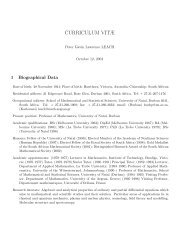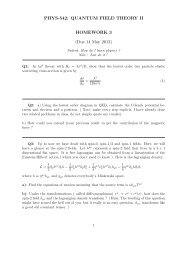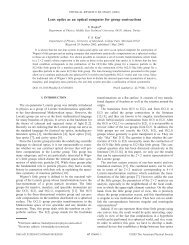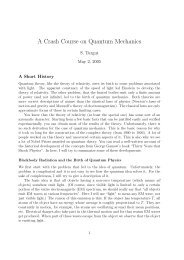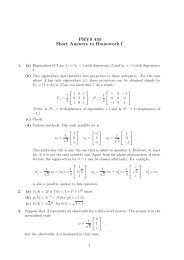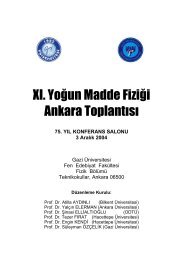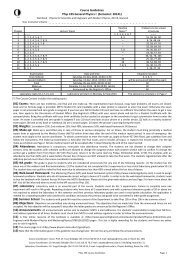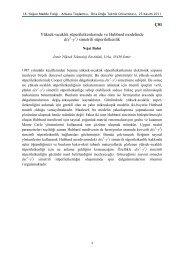SExtractor Draft - METU Astrophysics
SExtractor Draft - METU Astrophysics
SExtractor Draft - METU Astrophysics
- No tags were found...
Create successful ePaper yourself
Turn your PDF publications into a flip-book with our unique Google optimized e-Paper software.
206.4 DeblendingEach time an object extraction is completed, the connected set of pixels passes through a sortof filter that tries to split it into eventual overlapping components. This case appears morefrequently when the field is crowded or when the detection threshold is set very low. Thedeblending method adopted in <strong>SExtractor</strong>, is based on multi-thresholding, and works on anykind of object; but it is unable to deblend components that are so close that no saddle is presentin their profile. However, as no assumption has to be made on the shape of the objects, it isperfectly suited for galaxies as well as for high galactic latitude stellar fields.Typical problematic cases for deblending include patchy, extended Sc galaxies (which haveto be considered as single entities), and close or interacting pairs of optically faint galaxies(which have to be considered as separate objects). Basically, the multi-thresholding algorithmemploys a multiple isophotal analysis technique similar to those in use at the APM and theCOSMOS machines (Beard, McGillivray and Thanish 1991); in a first time, each extracted setof connected pixels is re-thresholded at N levels linearly or exponentially spaced between itsprimary extraction threshold and its peak value. This gives us a sort of 2-dimensional “model”of the light distribution within the object(s), which is stored in the form of a tree structure (fig.3). Then the algorithm goes downwards, from the tips of branches to the trunk, and decidesat each junction whether it shall extract two (or more) objects or continue its way down. Tomeet the conditions described earlier, the following simple decision criteria are adopted: at anyjunction threshold t i , any branch will be considered as a separate component if(1) the integrated pixel intensity (above t i ) of the branch is greater than a certain fraction δ cof the total intensity of the composite object.(2) condition (1) is verified for at least one more branch at the same level i.Note that ideally, condition (1) is both flux- and scale-invariant. However for faint, poorlyresolved objects, the efficiency of the deblending is limited mostly by seeing and sampling.From the analysis of both small and extended galaxy images, a compromise value for the contrastparameter δ c ∼ 0.005 proved to be optimum. This should normally exclude to separate objectswith a difference in magnitude greater than ≈ 6.The outlying pixels with flux lower than the separation thresholds have to be reallocated tothe proper components of the merger. To do so, we have opted for a statistical approach: ateach faint pixel we compute the contribution which is expected from each sub-object using abivariate Gaussian fit to its profile, and turn it into a probability for that pixel to belong to thesub-object. For instance, a faint pixel lying halfway between two close bright stars having thesame magnitude will be appended to one of these with equal probabilities. One big advantageof this technique is that the morphology of any object is completely defined simply through itslist of pixels.To test the effects of deblending on photometry and astrometry measurements, we made severalsimulations of photographic images of double stars with different separations and magnitudesunder typical observational conditions (fig. 4). It is obvious that multiple isophotal techniquesfail when there is no saddle point present in profiles (i.e. for distance between stars < 2σ in thecase of Gaussian images). We measured a magnitude error ≤ 0.2 mag and a shift of the centroid(≤ 0.4 pixels) for the fainter star in the very worst cases, but no other systematic effects werenoticeable.The user can control the multi-thresholding operation through 3 parameters. The first one isthe number of deblending thresholds (DEBLEND NTHRESH). A good value is 32. Higher values



